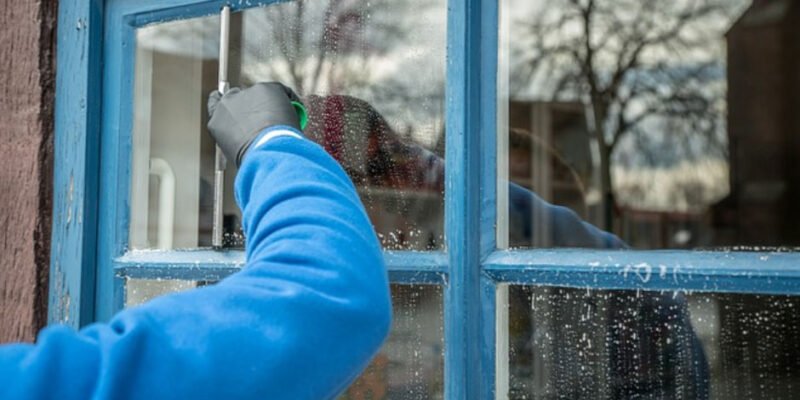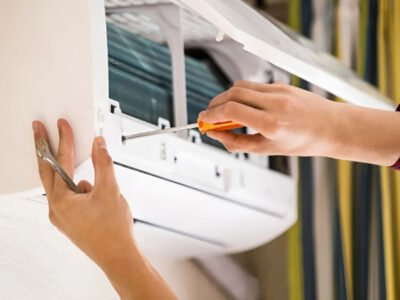Window tinting is a popular and practical enhancement for vehicles and homes alike. It not only adds a touch of style but also serves functional purposes, such as UV protection and increased privacy. However, like any feature, window tinting is subject to wear and tear over time.
In this article, we’ll guide you through the process of replacing your old window tint. Whether you’re dealing with fading colors, bubbling, or simply want an upgrade, understanding the signs and steps involved in replacement is crucial.
Signs it’s Time for Replacement
Fading and Discoloration
One of the first indicators that your window tint needs replacement is fading and discoloration. Over time, exposure to UV rays can take a toll on the tint’s vibrancy, causing it to lose its original color. Keep an eye out for these visual cues, as they not only compromise the aesthetics but also indicate a decrease in UV protection.
Fading occurs as UV rays penetrate the tint material, breaking down the pigments that give it color. The result is a less vibrant appearance, diminishing the overall appeal and functionality of the tint.
Bubbling and Peeling
Another common issue is the appearance of bubbles and peeling. This occurs when the adhesive that binds the tint to the window surface weakens. Besides being unsightly, bubbling and peeling compromise the tint’s effectiveness, leaving your windows vulnerable to UV rays and reducing overall insulation.
When the adhesive deteriorates, it loses its ability to maintain a secure bond between the tint and the window. This leads to the formation of bubbles, which not only obstruct visibility but also create an uneven surface. Additionally, peeling tint exposes the underlying glass, making it susceptible to external elements.
Preparing for Replacement
Gathering Necessary Tools and Materials
Before diving into the replacement process, ensure you have all the necessary tools and materials. This includes a heat gun or steamer, a razor blade, cleaning solution, and, of course, the replacement tint. Having everything in order will make the process smoother and more efficient.
Gathering the right tools is crucial for a successful replacement. A heat gun or steamer is essential for softening the old tint, making it easier to remove. A sharp razor blade ensures precise cutting and removal, while a quality cleaning solution helps prepare the window surface for the new tint.
Assessing the Condition of Current Tint
Take the time to inspect the current condition of your window tint. If there’s significant damage or if the tint is already peeling off, removal might be necessary. However, if it’s still in good shape, you might only need to replace certain sections.
Carefully examine the entire window surface to identify areas of concern. If the tint is only slightly faded or has minor issues, partial replacement may be an option. However, extensive damage or peeling may require a complete removal and replacement of the entire tint.
Removing Old Tint
Replacing your old window tint requires a methodical approach to ensure a safe and effective removal process. Here’s a step-by-step guide to help you navigate through the removal stage:
Step 1: Gather the Necessary Tools
Before you begin, make sure you have all the essential tools for the removal process. You will need:
- Heat gun or steamer
- Razor blade or utility knife
- Glass cleaner or mild soapy water
- Clean, lint-free cloths
- Plastic garbage bags
Step 2: Prepare the Work Area
Choose a well-ventilated area to work in. This will help dissipate any fumes that may be produced during the removal process. Lay down plastic garbage bags to catch any debris or adhesive remnants and protect the surrounding surfaces.
Step 3: Use the Heat Gun or Steamer
Start by using a heat gun or steamer to soften the adhesive that binds the old tint to the window. Hold the heat gun about six inches away from the tint and move it evenly across the surface. The goal is to make the adhesive more pliable.
Step 4: Begin Peeling the Tint
Once the tint is heated sufficiently, use a razor blade or utility knife to lift the edges of the tint carefully. Start from one corner and peel the tint away slowly. Work gradually, applying additional heat as needed to keep the adhesive soft.
Step 5: Continue Peeling
Continue peeling the tint, working from one edge to the other. Be patient and gentle to avoid tearing the tint or leaving adhesive residue on the window. If you encounter stubborn spots, apply more heat and carefully work through them.
Step 6: Remove Adhesive Residue
After removing the tint, you may find adhesive residue on the window. Use a glass cleaner or a mixture of mild soapy water to soften the adhesive further. Gently rub the residue with a clean, lint-free cloth to wipe it away.
Step 7: Scrape Away Residue
For stubborn residue, use a razor blade or utility knife to scrape it off gently. Hold the blade at a 45-degree angle to the glass to avoid scratches. Continue cleaning until the window is free of any adhesive remnants.
Step 8: Clean the Window Surface
Once all the tint and adhesive residue are removed, clean the window thoroughly with glass cleaner or the mild soapy water solution. Ensure that the window surface is entirely free of debris and residue before proceeding to the next steps.
Step 9: Dispose of Old Tint Properly
Dispose of the old tint and any collected debris in the plastic garbage bags. Seal the bags tightly and discard them according to your local waste disposal regulations. Some areas may have specific guidelines for the disposal of window tint material.
Step 10: Inspect the Window
Before moving on to the next steps of the replacement process, inspect the window for any damage or scratches. If you notice any issues, address them before installing the new tint to ensure a smooth and flawless finish.
Choosing the Right Replacement Tint
Understanding Different Types of Window Tint
There are various types of window tint, each with its own characteristics. Dyed film, metalized film, and hybrid film offer different levels of UV protection, heat reduction, and aesthetics. Consider your priorities and local regulations when selecting the replacement tint that suits your needs.
Considering Legal Regulations and Restrictions
Before finalizing your choice, familiarize yourself with local tinting laws. These regulations dictate the acceptable darkness and reflectivity levels for window tint. Ensure that your selected tint complies with these standards to avoid legal issues.
Installing the New Tint
After successfully removing the old window tint, it’s time to install the new tint. Proper installation is crucial to achieve a professional-looking finish. Follow these step-by-step instructions for a smooth and effective installation process:
Step 1: Gather the Necessary Tools and Materials
Before you begin the installation, make sure you have all the tools and materials required:
- New window tint
- Squeegee
- Spray bottle with a mixture of water and a small amount of mild soap
- Razor blade or utility knife
- Clean, lint-free cloths
- Heat gun or hairdryer
Step 2: Measure and Cut the Tint
Measure the dimensions of the window accurately, leaving a slight overlap on all sides. Lay the tint on a clean, flat surface and use a razor blade or utility knife to cut the tint according to your measurements. Ensure precision to avoid uneven edges during installation.
Step 3: Clean the Window Surface
Spray the window with the water and soap mixture. Wipe it down with a clean, lint-free cloth to ensure the surface is free of any dust, debris, or residue. A clean window provides a smooth foundation for the tint to adhere to.
Step 4: Peel Off the Protective Film
Most window tints come with a protective film on one side. Carefully peel off this film, exposing the adhesive side of the tint. Be cautious not to touch the adhesive, as oils from your skin can affect the tint’s effectiveness.
Step 5: Apply the Tint to the Window
Hold the tint by the edges and align it with the top of the window. Gently press the top edge of the tint against the window, leaving a small overhang at the top. Slowly lower the rest of the tint, allowing it to adhere to the window surface.
Step 6: Use a Squeegee to Remove Air Bubbles
Starting from the center and working outward, use a squeegee to smooth out the tint, removing any air bubbles. Apply even pressure as you work, ensuring the tint adheres uniformly to the window. Continue this process until the entire tint is applied.
Step 7: Trim Excess Tint
Once the tint is applied, use a razor blade or utility knife to trim any excess material along the edges of the window. Hold the blade at a slight angle to create clean, straight cuts. Take your time to achieve a professional and polished appearance.
Step 8: Heat the Tint
Use a heat gun or hairdryer to heat the applied tint gently. This step helps the adhesive bond securely to the window surface and aids in the removal of any remaining air bubbles. Move the heat source evenly across the tinted area.
Step 9: Smooth Out Any Remaining Bubbles
While the tint is still warm from the heat gun, use the squeegee to smooth out any remaining bubbles. Apply gentle pressure and work from the center towards the edges. Heating and smoothing ensure a flawless and professional finish.
Step 10: Allow the Tint to Cure
Finally, allow the tint to cure according to the manufacturer’s recommendations. During this curing period, avoid rolling down the windows or touching the tinted surface. This ensures the adhesive fully bonds with the window, providing long-lasting results.
Curing and Drying Process
Importance of Allowing the Tint to Cure
After installation, it’s crucial to let the tint cure. This enhances its durability and longevity. Different types of tint may have varying curing times, so follow the manufacturer’s recommendations to ensure optimal performance.
Common Mistakes During the Drying Process
Be mindful of potential issues during the drying process. Rushing this stage can result in premature tint damage. Patience is key, and avoiding contact with the tinted surface during the initial curing period is essential.
Maintenance Tips for New Tint
Cleaning and Care Instructions
To prolong the life of your new tint, follow proper cleaning and care instructions. Use recommended cleaning products and avoid abrasive materials that could scratch the surface. Regular maintenance not only keeps your windows looking good but also ensures the tint performs at its best.
Addressing Potential Issues Early On
Keep an eye out for any signs of damage or issues with the new tint. Addressing problems early on can prevent further deterioration. Quick fixes for minor problems can save you from having to replace the entire tint prematurely.
Cost Considerations
Budgeting for DIY vs. Professional Installation
Consider your budget when deciding between a DIY project and professional installation. While DIY may save money on labor costs, professional help ensures a flawless finish and may be worth the investment. Factor in the cost of materials, potential additional expenses, and the long-term savings associated with quality tint.
Research the prices of tint materials and compare them to the costs of professional installation services. Assess your skill level and the complexity of the job before deciding. In some cases, the peace of mind and quality assurance provided by professional installers may outweigh the upfront costs.
Conclusion
In conclusion, replacing your old window tint is a manageable task with the right knowledge and approach. By recognizing the signs of wear, preparing adequately, and choosing the right replacement tint, you can enhance both the aesthetics and functionality of your windows.
Whether you opt for a DIY project or seek professional assistance, the key is to prioritize the long-term benefits of well-maintained window tint. A well-executed replacement ensures your windows continue to provide the desired benefits for years to come, from UV protection to improved privacy and a sleek appearance.















Comments